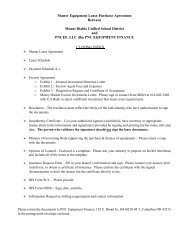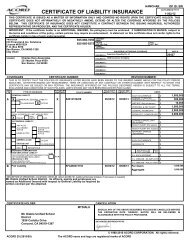Study of the Mount Diablo Unified School District - Mt. Diablo Unified ...
Study of the Mount Diablo Unified School District - Mt. Diablo Unified ...
Study of the Mount Diablo Unified School District - Mt. Diablo Unified ...
- No tags were found...
Create successful ePaper yourself
Turn your PDF publications into a flip-book with our unique Google optimized e-Paper software.
CHAPTER 3: SERVICE DELIVERY OPTIONS AND CONTINUUM OF SERVICESThis chapter reviews <strong>the</strong> delivery <strong>of</strong> instructional services to <strong>Mt</strong>. <strong>Diablo</strong> <strong>Unified</strong> <strong>School</strong><strong>District</strong> (MDUSD) students with disabilities. The district provides a full continuum <strong>of</strong>services from least restrictive to most restrictive setting. Sections in this chapter include:3.1 General Education Consultation3.2 Academic Resource Support3.3 Full‐time Instruction3.4 Nonpublic Placements3.5 Related Services3.1 General Education ConsultationIssue 3.1: Collaborative Consultation.MDUSD provides a collaborative consultation model <strong>of</strong> instructional delivery for studentswith disabilities in <strong>the</strong> general education setting. While <strong>the</strong> model is working well in someschools, it is underutilized in o<strong>the</strong>r schools. In general education consultation, typically aspecial education and a general education teacher collaboratively teach in <strong>the</strong> sameclassroom. In some situations, <strong>the</strong> general education teacher works collaboratively with aspecial education assistant to meet <strong>the</strong> needs <strong>of</strong> students with disabilities or to provideaccommodations to students with Section 504 plans in <strong>the</strong> general education classroom.Collaborative classroom observations by MGT consultants indicate that <strong>the</strong> majority <strong>of</strong> <strong>the</strong>MDUSD collaborative teachers used a teach/assist model where one teacher delivers <strong>the</strong>instruction (typically <strong>the</strong> general education teacher) and <strong>the</strong> o<strong>the</strong>r teacher (typically <strong>the</strong>special education teacher) assists students throughout <strong>the</strong> classroom. More specifically, <strong>of</strong><strong>the</strong> 100 classrooms visited, MGT consultants documented that 84 percent <strong>of</strong> <strong>the</strong> classroomsused <strong>the</strong> teach/assist collaborative model. In 12 percent <strong>of</strong> <strong>the</strong> collaborative classes, MGTobserved <strong>the</strong> use <strong>of</strong> various classroom centers or stations for instruction with both teachersproviding assistance to <strong>the</strong> students. The use <strong>of</strong> instructional technology such asSmartBoards, AlphaSmarts, and computers was observed by MGT consultants in only sevenpercent <strong>of</strong> <strong>the</strong> classrooms visited.Exhibits 3‐1 and 3‐2 show schools that demonstrate improved academic achievement <strong>of</strong>students with disabilities with a one‐year change in achievement, a five‐year change inachievement, and an average change in achievement across five years, as measured by <strong>the</strong>California State Test. These schools effectively implement a collaborative model <strong>of</strong> languagearts and ma<strong>the</strong>matics instruction and effective teaming to meet <strong>the</strong> needs <strong>of</strong> students withdiverse learning needs, such as those with disabilities under IDEA or Section 504. As shown,<strong>the</strong> achievement <strong>of</strong> students with disabilities at <strong>the</strong>se recognized schools exceed state anddistrict percentages for improvement on <strong>the</strong> California State Test.MGT <strong>of</strong> America, Inc. Page 3‐1















